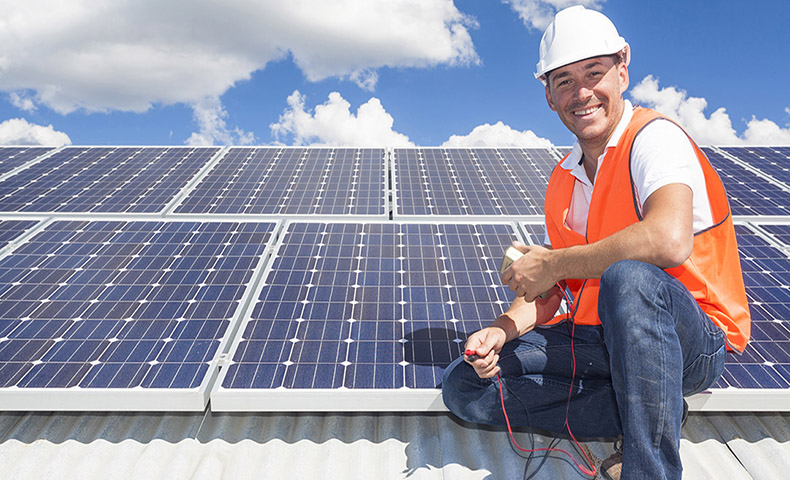
Once you’ve decided to put solar panels on your roof or property, you will surely be looking for an installer who can do the job. Picking one who is experienced is important, since the contractor will be getting the permits cleared for your solar installation and will work out the details of design and actual placement of the solar panels.
You should try to get several quotes from local solar installers in your area, read online reviews and meet with the top three that you select before making your final determination.
But this doesn’t mean you will have solar panels producing electricity from the sun right away.
On average, from the day you sign a contract with the installer, it should take about 35 days for your domestic solar power system to be up and running.
The time allows for all permits to be cleared and make sure that all the work is conducted safely and with precision.
The solar installer should conduct a thorough review of your home’s roof to make sure it’s in shape to receive the solar panels. They’ll determine this based on how old it is and if there are any leaks or other signs of wear and thread that could pose a problem. A reputable installer may not do the job if they don’t believe the roof is up to par, so consider this.
The installer will also check the electrical panel to see if it’s prepared for a new load. They will verify the interconnection method or the way the solar array will plug into the electrical panel and, as a safety measure, make certain the panel is up to code.
Once those things have been cleared, it’s time to deal with the utility. Most residential solar panels are grid-tie, meaning you will continue to be connected to your utility. This allows you to sell excess energy to the company in exchange for credit for the power you get from them at night, when your panels don’t produce any electricity.
The installer will submit an interconnection application to the electric utility. Homes without solar do not push power back to the utility grid, they only pull power from it. The interconnection application gives the utility a heads up that something new is going to be happening at the home. In response, the utility will perform a screening to make sure the grid can safely transport and use the excess solar energy the home’s new solar array will produce.
While the utility is screening the interconnection application, the installer will attend to the permits. The process can be easy or complicated depending on the municipality where you live. Bigger cities might have the process streamlined, while smaller jurisdictions might not. That’s why it’s important to pick a solar installer who knows his way around this, so he can solve issues or anticipate any problems.
The municipality must be notified that there will be modifications made to the house, in this case, the addition of solar panels. The local government will make sure that the installer has all the licenses required to conduct such a job and that the plans submitted abide with all building and electrical code requirements.
Once the utility and municipality approve the applications, the installer is cleared to go ahead and do the actual installation of the solar array. By this time, the solar installer would have presented you already with a review of your energy needs. He would also have recommended the appropriate design and size of your residential solar power system. Depending on the layout and the number of panels to be used, the work can last 1-2 days.
When work is completed, the installer will make sure everything is in working order, but it doesn’t mean you can turn it on yet.
You can expect a visit from a representative of the utility company and the municipality to inspect and ensure the work has been done properly.
The inspections may take some time and require someone to be at home during the day. After they are finished and are satisfied with their review, they will allow the domestic solar power system to be turned on and you can start producing electricity from sunshine.
Depending on where you leave there may be more steps to this process, but overall is meant to make sure everything is done correctly and legal to prevent problems in the future.
Before your installer leaves your site, he should explain all warranties associated with the panels, inverters and other aspects of your solar array. He should also provide you with his own warranty for the work performed.
Residential solar panels are expected to last more than 25 years and the inverter about 10-15, so after your solar power system is turned on you won’t have much to do in terms of maintenance for quite some time, apart from cleaning the solar panels from time to time.
HahaSmart Blog - More Solar Tips and Guide
HahaSmart News - Stay Informed
Your Solar Incentives - See Credits and Incentives in Your Area
Check Your Home's Solar Price - See How Much You Save
Register Now - Unlock The Lowest Solar Prices in Your Area


Input your address to see if it is solar friendly and how much you can save with solar.
Great. Your address is perfect for solar. Solar incentive is still available. Select monthly utility cost and calculate the size of solar system you will need now.
| kw System size | years Payback period | Lifetime savings |
No money down, 100% finance is available.
|
|
Sign up to understand more about solar panel costs, see quote right away |
Comments